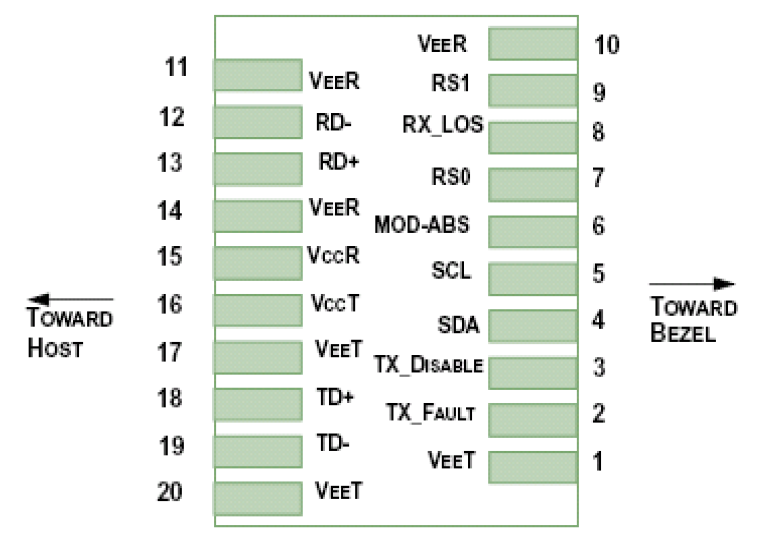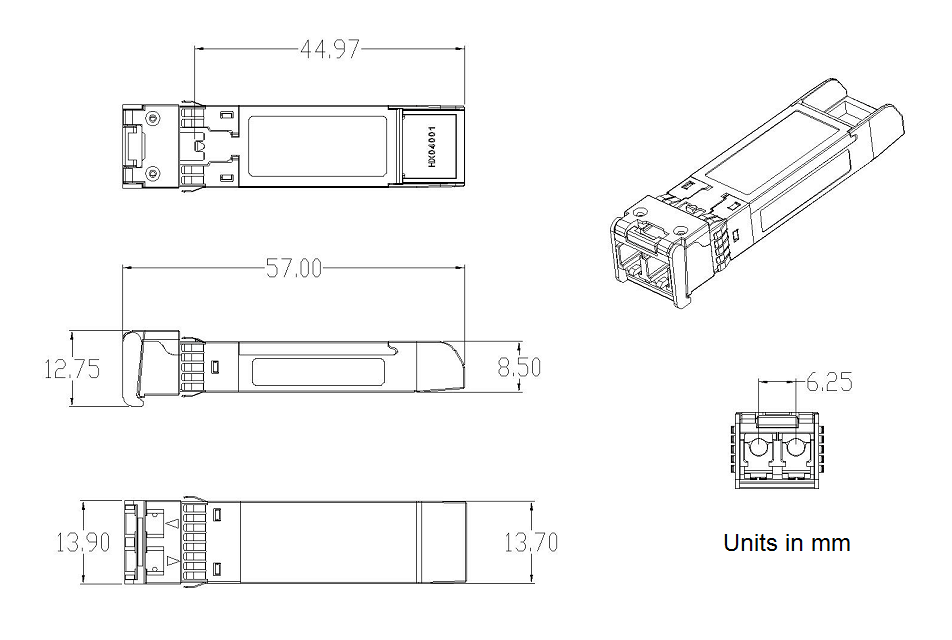Dongguan Phynam Comtech Co.,Limited
25Gb/s SFP28 1310nm 10km Fiber Channel Transceiver Module
PH-SFP28/25G-LR
FEATURES
APPLICATIONS
Absolute Maximum Ratings
It has to be noted that the operation in excess of any individual absolute maximum ratings might cause permanent damage to this module.
|
Parameter |
Symbol |
Unit |
Min |
Max |
|
Storage Temperature Range |
Ts |
℃ |
-40 |
85 |
|
Relative Humidity |
RH |
% |
5 |
95 |
|
Maximum Supply Voltage |
Vcc |
V |
-0.5 |
3.6 |
|
Damage Threshold |
THd |
dBm |
3 |
Recommended Operating Conditions and Power Supply Requirements
|
Parameter |
Symbol |
Unit |
Min |
Typ |
Max |
Note |
|
Operating Case Temperature Range |
Tc |
℃ |
0 |
70 |
commercial |
|
|
Power Supply Voltage |
Vcc |
V |
3.135 |
3.3 |
3.465 |
|
|
Data Rate |
Gb/s |
25 |
||||
|
Control Input Voltage High |
V |
2 |
Vcc |
|||
|
Control Input Voltage Low |
V |
0 |
0.8 |
1 |
||
|
Link Distance (SMF) |
D |
KM |
10 |
9/125um |
General Description
PH-SFP28/25G-LR 25Gb/s SFP28 transceiver consists of five sections: the LD driver, the limiting amplifier, the digital diagnostic monitor, the DFB laser and the PIN photo-detector .The module data link up to 10km in 9/125um single mode fiber.
The SFP28 LR module electrical interface is compliant to SFI electrical specifications. The transmitter input and receiver output impedance is 100 Ohms differential. Data lines are internally AC coupled. The module provides differential termination and reduce differential to common mode conversion for quality signal termination and low EMI. SFI typically operates over 200 mm of improved FR4 material or up to about 150mmof standard FR4 with one connector.
The transmitter converts 25Gbit/s serial PECL or CML electrical data into serial optical data compliant with the 25GBASE-LR standard. An open collector compatible Transmit Disable (Tx_Dis) is provided. Logic “1” or no connection on this pin will disable the laser from transmitting. Logic “0” on this pin provides normal operation. The transmitter has an internal automatic power control loop (APC) to ensure constant optical power output across supply voltage and temperature variations. An open collector compatible Transmit Fault (Tx_Fault) is provided. TX_Fault is module output contact that when high, indicates that the module transmitter has detected a fault condition related to laser operation or safety. The TX_Fault output contact is an open drain/collector and shall be pulled up to the Vcc_Host in the host with a resistor in the range 4.7-10 kΩ. TX_Disable is a module input contact. When TX_Disable is asserted high or left open, the SFP28 module transmitter output shall be turned off. This contact shall be pulled up to VccT with a 4.7 kΩ to 10 kΩ resistor.
The receiver converts 25Gbit/s serial optical data into serial PECL/CML electrical data. An open collector compatible Loss of Signal is provided. Rx_LOS when high indicates an optical signal level below that specified in the relevant standard. The Rx_LOS contact is an open drain/collector output and shall be pulled up to Vcc_Host in the host with a resistor in the range 4.7-10 kΩ, or with an active termination. Power supply filtering is recommended for both the transmitter and receiver. The Rx_LOS signal is intended as a preliminary indication to the system in which the SFP28 is installed that the received signal strength is below the specified range. Such an indication typically points to non-installed cables, broken cables, or a disabled, failing or a powered off transmitter at the far end of the cable.
Pin Assignment and Pin Description

Figure1. Diagram of host board connector block pin numbers and names
Pin Descriptions
|
Pin |
Symbol |
Name |
Ref. |
|
1 |
VeeT |
Transmitter ground |
1 |
|
2 |
TX Fault |
Transmitter fault indication |
|
|
3 |
Tx Disable |
Disables the transmitter or laser output |
2 |
|
4 |
SDA |
Data line for an I2C series interface |
2 |
|
5 |
SCL |
Clock line for an I2C series interface |
|
|
6 |
Mod_ABS |
Indicates the module online state (this pin is connected to the VeeT or VeeR pin) |
|
|
7 |
RS0 |
Selects a rate for the module (this pin is connected to the 33 kilohm resistor) |
|
|
8 |
RX_LOS |
Indicates a loss of received signals |
|
|
9 |
RS1 |
Selects a rate for the module (this pin is connected to the 33 kilohm resistor) |
|
|
10 |
VeeR |
Receiver ground |
1 |
|
11 |
VeeR |
Receiver ground |
1 |
|
12 |
RD- |
Inverse received data output |
|
|
13 |
RD+ |
Received data output |
|
|
14 |
VeeR |
Receiver ground |
1 |
|
15 |
VccR |
3.3 V receiver power |
|
|
16 |
VccT |
3.3 V transmitter power |
|
|
17 |
VeeT |
Transmitter ground |
1 |
|
18 |
TD+ |
Transmit data input |
|
|
19 |
TD- |
Inverse transmit data input |
|
|
20 |
VeeT |
Transmitter ground |
1 |
Notes:
1. Module ground pins GND are isolated from the module case.
2. Shall be pulled up with 4.7K-10Kohms to a voltage between 3.15V and 3.45V on the host board.
Electric Ports Definition
The following electrical characteristics are defined over the Recommended Operating Environment unless otherwise specified.
|
Parameter |
Symbol |
Min. |
Typ. |
Max |
Unit |
Notes |
|
Power Consumption |
p |
1.5 |
W |
|||
|
Supply Current |
Icc |
450 |
mA |
|||
|
Transmitter |
||||||
|
Single-ended Input Voltage Tolerance |
Vcc |
-0.3 |
4.0 |
V |
||
|
common mode voltage tolerance |
15 |
mV |
||||
|
Differential Input Voltage Swing |
Vin,pp |
180 |
700 |
mVpp |
||
|
Differential Input Impedance |
Zin |
90 |
100 |
110 |
Ohm |
1 |
|
Transmit Disable Assert Time |
10 |
us |
||||
|
Transmit Disable Voltage |
Vdis |
Vcc-1.3 |
Vcc |
V |
||
|
Transmit Enable Voltage |
Ven |
Vee |
Vee +0.8 |
V |
2 |
|
|
Receiver |
||||||
|
Single-ended Input Voltage Tolerance |
Vcc |
-0.3 |
4.0 |
V |
||
|
Differential Output Voltage Swing |
Vout,pp |
300 |
900 |
mVpp |
||
|
Differential Output Impedance |
Zout |
90 |
100 |
110 |
Ohm |
3 |
|
Data output rise/fall time |
Tr/Tf |
9.5 |
ps |
4 |
||
|
LOS Assert Voltage |
VlosH |
Vcc-1.3 |
Vcc |
V |
5 |
|
|
LOS De-assert Voltage |
VlosL |
Vee |
Vee +0.8 |
V |
5 |
|
Notes:
1. Connected directly to TX data input pins. AC coupled thereafter.
2. Or open circuit.
3. Input 100 ohms differential termination.
4. These are unfiltered 20-80% values.
5. Loss of Signal is LVTTL. Logic 0 indicates normal operation; logic 1 indicates no signal detected.
Optical Characteristics
The following optical characteristics are defined over the Recommended Operating Environment unless otherwise specified.
|
Parameter |
Symbol |
Min. |
Typical |
Max |
Unit |
Notes |
|
Transmitter |
||||||
|
Center Wavelength |
λC |
1290 |
1310 |
1330 |
nm |
|
|
Optical Spectral Width |
∆λ |
1 |
nm |
|||
|
Average Optical Power |
PAVG |
-8.4 |
3 |
dBm |
1 |
|
|
Side Mode Suppression Ratio |
SMSR |
30 |
dB |
|||
|
Optical Extinction Ratio |
ER |
3.5 |
dB |
|||
|
Transmitter OFF Output Power |
Poff |
-30 |
dBm |
|||
|
Transmitter and Dispersion Penalty |
TDP |
4.4 |
dB |
|||
|
Optical Return Loss Tolerance |
ORLT |
12 |
dB |
|||
|
Transmitter Eye Mask |
Compliant with IEEE802.3ae |
|||||
|
Receiver |
||||||
|
Center Wavelength |
λC |
1260 |
1310 |
1360 |
nm |
|
|
Receiver Sensitivity in average power |
Sen. |
-10.4 |
dBm |
2 |
||
|
Receiver Sensitivity in OMA |
Sen. |
-8.6 |
dBm |
2 |
||
|
Stressed Sensitivity (OMA) |
-6.8 |
dBm |
2 |
|||
|
Input Saturation Power (overload) |
Psat |
0.5 |
dBm |
|||
|
LOS Assert |
LOSA |
-22 |
dBm |
|||
|
LOS De-assert |
LOSD |
-11.5 |
dBm |
|||
|
Optical Return Loss |
ORL |
12 |
dB |
|||
|
LOS Hysteresis |
LOSH |
0.5 |
dB |
|||
Notes:
1. Class 1 Laser Safety per FDA/CDRH and IEC-825-1 regulations.
2. Measured with Light source 1310nm, ER=3.5dB; BER =<10^-12 @ PRBS=2^31-1 NRZ.
Mechanical Dimensions
